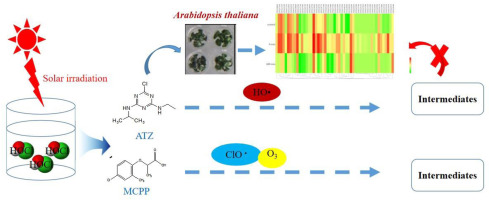当前位置:
X-MOL 学术
›
Water Res.
›
论文详情
Our official English website, www.x-mol.net, welcomes your feedback! (Note: you will need to create a separate account there.)
Solar irradiation combined with chlorine can detoxify herbicides.
Water Research ( IF 12.8 ) Pub Date : 2020-04-05 , DOI: 10.1016/j.watres.2020.115784 Xiujuan Kong 1 , Liping Wang 1 , Zihao Wu 1 , Fanli Zeng 2 , Huiying Sun 2 , Kaiheng Guo 1 , Zhechao Hua 1 , Jingyun Fang 1
Water Research ( IF 12.8 ) Pub Date : 2020-04-05 , DOI: 10.1016/j.watres.2020.115784 Xiujuan Kong 1 , Liping Wang 1 , Zihao Wu 1 , Fanli Zeng 2 , Huiying Sun 2 , Kaiheng Guo 1 , Zhechao Hua 1 , Jingyun Fang 1
Affiliation

|
The solar/chlorine process is an energy-efficient advanced oxidation process that can produce reactive species such as hydroxyl radical, reactive chlorine species and ozone. This study investigated the process' ability to detoxify the typical herbicides atrazine and mecoprop (methylchlorophenoxypropionic acid). Both herbicides are resistant to direct solar photolysis or chlorination alone, but they can be degraded by the solar/chlorine process effectively. Atrazine inhibited the development of Arabidopsis thaliana, but such inhibition was negligible after solar/chlorine treatment of an atrazine solution. The transformation of atrazine in the process was shown to be through hydroxylation, hydrogen abstraction and dechlorination but did not involve chlorine substitution or addition. Cl• reacts with atrazine and mecoprop with rate constants of 6.87 × 109 M-1s-1 and 1.08 × 1010 M-1s-1, respectively, while ClO• reacts with mecoprop with a rate constant of 1.11 × 108 M-1s-1. The degradation kinetics of atrazine and mecoprop by solar/chlorine was simulated by modeling, which fitted the experimental results well. Hydroxyl radicals (HO•) mainly contributed to the degradation of atrazine by solar/chlorine at pH 7 with the contribution of 65%, whereas ClO• and O3 were main species responsible for the degradation of mecoprop with the contribution of 72% and 17%, respectively. The pseudo-first-order rate constants (k's) of the two degradations increased substantially (by 28.8% for atrazine and by 198% for mecoprop) when the chlorine dosage was increased from 50 μM to 200 μM. The k's decreased with increasing pH. The presence of natural organic matter inhibited the degradation of both herbicides, while the presence of bromide enhanced their degradation. This work reveals a feasible method for the detoxifying herbicides by combining chlorine with solar radiation.
中文翻译:

太阳辐射与氯结合可以使除草剂排毒。
太阳/氯气工艺是一种节能高效的高级氧化工艺,可以产生诸如氢氧根,氯气和臭氧等反应性物质。这项研究调查了该工艺对典型除草剂at去津和甲丙酸(甲基氯苯氧基丙酸)的排毒能力。两种除草剂仅能抵抗直接的日光光解或氯化作用,但是它们可以通过日光/氯化过程有效地降解。阿特拉津抑制拟南芥的发育,但是在对阿特拉津溶液进行日光/氯处理后,这种抑制作用可以忽略不计。结果表明of去津的转化是通过羟基化,夺氢和脱氯进行的,但不涉及氯的取代或添加。Cl•与at去津和甲丙酸反应的速率常数为6。ClO•与甲丙酸以1.11×108 M-1s-1的速率常数反应,分别为87×109 M-1s-1和1.08×1010 M-1s-1。通过模拟模拟了日光/氯气中阿特拉津和甲丙丙的降解动力学,与实验结果吻合良好。羟基自由基(HO•)主要是在pH为7的条件下通过太阳/氯降解了阿特拉津,其贡献率为65%,而ClO•和O3是引起甲丙酸降解的主要物质,分别为72%和17%。 , 分别。当氯的剂量从50μM增加到200μM时,两个降解的拟一级反应常数(k's)显着增加(阿特拉津增加28.8%,甲丙醇增加198%)。随着pH值的增加,k值降低。天然有机物的存在抑制了两种除草剂的降解,而溴化物的存在则增强了它们的降解。这项工作揭示了一种通过将氯与太阳辐射结合而对除草剂进行解毒的可行方法。
更新日期:2020-04-06
中文翻译:

太阳辐射与氯结合可以使除草剂排毒。
太阳/氯气工艺是一种节能高效的高级氧化工艺,可以产生诸如氢氧根,氯气和臭氧等反应性物质。这项研究调查了该工艺对典型除草剂at去津和甲丙酸(甲基氯苯氧基丙酸)的排毒能力。两种除草剂仅能抵抗直接的日光光解或氯化作用,但是它们可以通过日光/氯化过程有效地降解。阿特拉津抑制拟南芥的发育,但是在对阿特拉津溶液进行日光/氯处理后,这种抑制作用可以忽略不计。结果表明of去津的转化是通过羟基化,夺氢和脱氯进行的,但不涉及氯的取代或添加。Cl•与at去津和甲丙酸反应的速率常数为6。ClO•与甲丙酸以1.11×108 M-1s-1的速率常数反应,分别为87×109 M-1s-1和1.08×1010 M-1s-1。通过模拟模拟了日光/氯气中阿特拉津和甲丙丙的降解动力学,与实验结果吻合良好。羟基自由基(HO•)主要是在pH为7的条件下通过太阳/氯降解了阿特拉津,其贡献率为65%,而ClO•和O3是引起甲丙酸降解的主要物质,分别为72%和17%。 , 分别。当氯的剂量从50μM增加到200μM时,两个降解的拟一级反应常数(k's)显着增加(阿特拉津增加28.8%,甲丙醇增加198%)。随着pH值的增加,k值降低。天然有机物的存在抑制了两种除草剂的降解,而溴化物的存在则增强了它们的降解。这项工作揭示了一种通过将氯与太阳辐射结合而对除草剂进行解毒的可行方法。



























 京公网安备 11010802027423号
京公网安备 11010802027423号